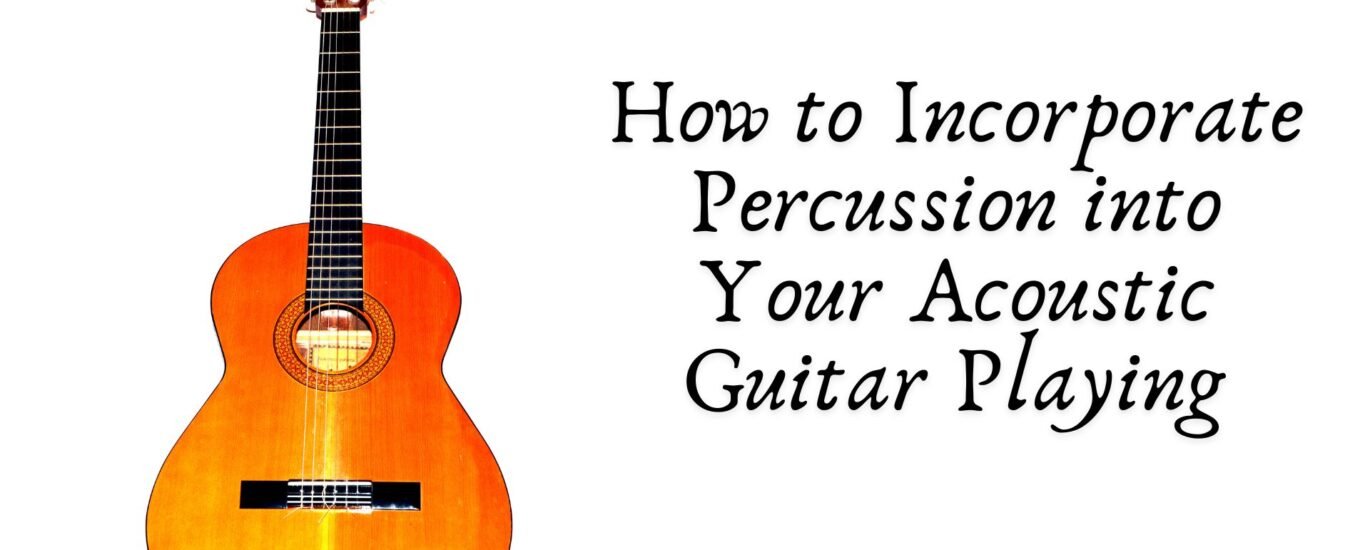Acoustic guitar is an incredibly versatile instrument, and one of the best ways to make your playing more dynamic and engaging is by incorporating percussion techniques. By using your guitar as both a melodic and rhythmic instrument, you can create rich, layered sounds that make solo performances more captivating and add new dimensions to group playing. In this guide, we will explore various percussive techniques and how to integrate them into your acoustic guitar playing.
Understanding the Basics of Guitar Percussion
Percussive guitar playing involves striking or tapping different parts of the guitar body to produce drum-like sounds. The most common techniques include tapping the body, slapping the strings, and incorporating palm hits on the bridge or soundboard. Mastering these techniques can help you create rhythm patterns that mimic a drummer’s beats.
Key Percussive Sounds
- Kick Drum Effect: Created by tapping the lower bout of the guitar with the palm or heel of your hand.
- Snare Drum Effect: Achieved by slapping the strings with your thumb or fingers near the soundhole.
- Hi-Hat Effect: Lightly tapping the strings with the side of your palm or fingertips for a crisp, high-pitched sound.
- Tom Drum Effect: Using knuckles or fingertips on different parts of the guitar body to produce varied drum tones.
Slap and Tap Techniques
Adding slaps and taps into your strumming or fingerpicking can bring a percussive groove to your playing. Here are some simple techniques to get started:
Palm Slaps
- While strumming, use the side of your picking hand to slap the lower strings. This creates a muted, snare-like effect.
- Combine palm slaps with regular chord changes to add rhythmic accents.
Thumb Taps
- While fingerpicking, use your thumb to tap the body of the guitar near the bridge in between plucked notes.
- This technique helps in maintaining a steady beat while playing melodic lines.
Body Taps
- Experiment with tapping different areas of the guitar’s body using your fingers or knuckles.
- The top, sides, and lower bout all produce unique sounds that can be incorporated into a rhythm.
Integrating Percussion with Chords and Melodies
Once you’re comfortable with basic percussive techniques, the next step is to blend them into your regular playing style.
Strumming with Percussion
- While strumming chords, introduce muted strums (by lightly resting your palm on the strings) to create a rhythmic pulse.
- Use a percussive hit on the guitar body in place of every second or fourth beat to mimic a snare drum.
Fingerstyle Percussion
- Play bass notes with your thumb while using your fingers to pluck melodies.
- Add a tap on the soundboard or a slap on the strings in between notes to maintain rhythm.
Flamenco-Inspired Rasgueado and Golpe
- Rasgueado: A rapid, rhythmic flicking of the fingers over the strings, common in flamenco music.
- Golpe: A quick tap on the guitar top using the ring finger or palm to create a snare-like effect.
Using Percussion to Enhance Song Arrangements
Adding percussive elements can make your solo performances feel more complete, especially if you’re playing without a backing band.
Building Groove-Based Arrangements
- Identify where beats naturally fall in a song and replace some strums with percussive hits.
- Use the kick-snare pattern (heel of the hand for the kick, slap for the snare) to create a rhythm section effect.
Looping and Layering
- If you use a loop pedal, you can first record a percussive rhythm layer and then play chords or melodies over it.
- Even without a looper, alternating between percussive playing and strumming can simulate layered instrumentation.
Advanced Percussion Techniques
Once you have mastered the basics, you can explore more advanced techniques to further enhance your playing.
Ghost Notes and Harmonic Slaps
- Play ghost notes (lightly muted string hits) in between your regular notes to add groove.
- Harmonic slaps involve striking the strings at natural harmonic points (like the 12th fret) while incorporating percussion.
Drum Rolls and Scrapes
- Use fingertips to rapidly tap a roll on the soundboard.
- Scrape your fingernails or a pick across wound strings for a brush-like percussion sound.
Integrating Stomp and Foot Percussion
- Some players use a stompbox or foot tambourine to add extra rhythm while playing percussive guitar.
- This approach can make solo performances sound fuller and more dynamic.
Exercises to Develop Your Percussive Guitar Skills
Practicing percussive guitar playing requires coordination and control. Here are some exercises to help build your skills:
Exercise 1: Kick-Snare Groove
- Tap the lower bout (kick drum sound) on beat 1.
- Slap the strings (snare sound) on beat 2.
- Repeat while maintaining a simple chord progression.
Exercise 2: Percussive Strumming Pattern
- Strum down with your fingers.
- Upstroke with your thumb.
- Slap the strings with your palm.
- Upstroke with your fingers.
- Repeat at different speeds.
Exercise 3: Tapping and Fingerpicking
- Pluck bass notes with your thumb.
- Tap the soundboard with your index or middle finger.
- Pluck treble strings with your other fingers.
- Repeat while maintaining a steady rhythm.
Conclusion
Incorporating percussion into your acoustic guitar playing can transform your sound and open up new creative possibilities. By practicing the techniques outlined in this guide, you can develop a unique rhythmic style that enhances your playing and makes your performances more engaging. Whether you’re a solo performer or playing in a group, percussive guitar techniques can bring new life to your music and make you stand out as a musician. Start slow, experiment with different sounds, and gradually integrate percussion into your natural playing style. Happy playing!






